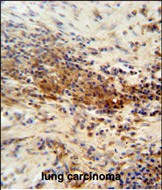DNAJC11 Antibody (N-term)
Affinity Purified Rabbit Polyclonal Antibody (Pab)
- SPECIFICATION
- CITATIONS
- PROTOCOLS
- BACKGROUND

Application
| IHC-P, WB, E |
|---|---|
| Primary Accession | Q9NVH1 |
| Other Accession | Q5U458, Q2NL21, NP_060668.2 |
| Reactivity | Human, Mouse |
| Predicted | Bovine |
| Host | Rabbit |
| Clonality | Polyclonal |
| Isotype | Rabbit IgG |
| Calculated MW | 63278 Da |
| Antigen Region | 27-56 aa |
| Gene ID | 55735 |
|---|---|
| Other Names | DnaJ homolog subfamily C member 11, DNAJC11 |
| Target/Specificity | This DNAJC11 antibody is generated from rabbits immunized with a KLH conjugated synthetic peptide between 27-56 amino acids from the N-terminal region of human DNAJC11. |
| Dilution | IHC-P~~1:50~100 WB~~1:1000 E~~Use at an assay dependent concentration. |
| Format | Purified polyclonal antibody supplied in PBS with 0.09% (W/V) sodium azide. This antibody is purified through a protein A column, followed by peptide affinity purification. |
| Storage | Maintain refrigerated at 2-8°C for up to 2 weeks. For long term storage store at -20°C in small aliquots to prevent freeze-thaw cycles. |
| Precautions | DNAJC11 Antibody (N-term) is for research use only and not for use in diagnostic or therapeutic procedures. |
| Name | DNAJC11 |
|---|---|
| Function | [Isoform 1]: Required for mitochondrial inner membrane organization. Seems to function through its association with the MICOS complex and the mitochondrial outer membrane sorting assembly machinery (SAM) complex. |
| Cellular Location | Mitochondrion. Note=Isoforms show differential submitochondrial localization. A 57 kDa form (potentially isoform 3) shows either mitochondrial matrix or innermembrane (IM) localization, possibly anchored to the IM facing the matrix. A 35 kDa form behaved either as an inner membrane space (IMS) or an IM protein exposed to the IMS. |

Thousands of laboratories across the world have published research that depended on the performance of antibodies from Abcepta to advance their research. Check out links to articles that cite our products in major peer-reviewed journals, organized by research category.
info@abcepta.com, and receive a free "I Love Antibodies" mug.
Provided below are standard protocols that you may find useful for product applications.
Background
Belongs to the DNAJC11 family. Three named isoforms produced by alternative splicing.
References
Kneissl, J., et al. Plant Cell 21(10):3212-3225(2009)
Xie, J., et al. FEBS Lett. 581(18):3545-3549(2007)
Lamesch, P., et al. Genomics 89(3):307-315(2007)
Henrich, K.O., et al. Eur. J. Cancer 43(3):607-616(2007)
Katoh, M., et al. Int. J. Oncol. 23(4):1219-1224(2003)
If you have used an Abcepta product and would like to share how it has performed, please click on the "Submit Review" button and provide the requested information. Our staff will examine and post your review and contact you if needed.
If you have any additional inquiries please email technical services at tech@abcepta.com.













 Foundational characteristics of cancer include proliferation, angiogenesis, migration, evasion of apoptosis, and cellular immortality. Find key markers for these cellular processes and antibodies to detect them.
Foundational characteristics of cancer include proliferation, angiogenesis, migration, evasion of apoptosis, and cellular immortality. Find key markers for these cellular processes and antibodies to detect them. The SUMOplot™ Analysis Program predicts and scores sumoylation sites in your protein. SUMOylation is a post-translational modification involved in various cellular processes, such as nuclear-cytosolic transport, transcriptional regulation, apoptosis, protein stability, response to stress, and progression through the cell cycle.
The SUMOplot™ Analysis Program predicts and scores sumoylation sites in your protein. SUMOylation is a post-translational modification involved in various cellular processes, such as nuclear-cytosolic transport, transcriptional regulation, apoptosis, protein stability, response to stress, and progression through the cell cycle. The Autophagy Receptor Motif Plotter predicts and scores autophagy receptor binding sites in your protein. Identifying proteins connected to this pathway is critical to understanding the role of autophagy in physiological as well as pathological processes such as development, differentiation, neurodegenerative diseases, stress, infection, and cancer.
The Autophagy Receptor Motif Plotter predicts and scores autophagy receptor binding sites in your protein. Identifying proteins connected to this pathway is critical to understanding the role of autophagy in physiological as well as pathological processes such as development, differentiation, neurodegenerative diseases, stress, infection, and cancer.



